brakes FIAT 500L LIVING 2015 2.G Owners Manual
[x] Cancel search | Manufacturer: FIAT, Model Year: 2015, Model line: 500L LIVING, Model: FIAT 500L LIVING 2015 2.GPages: 224, PDF Size: 5.92 MB
Page 3 of 224
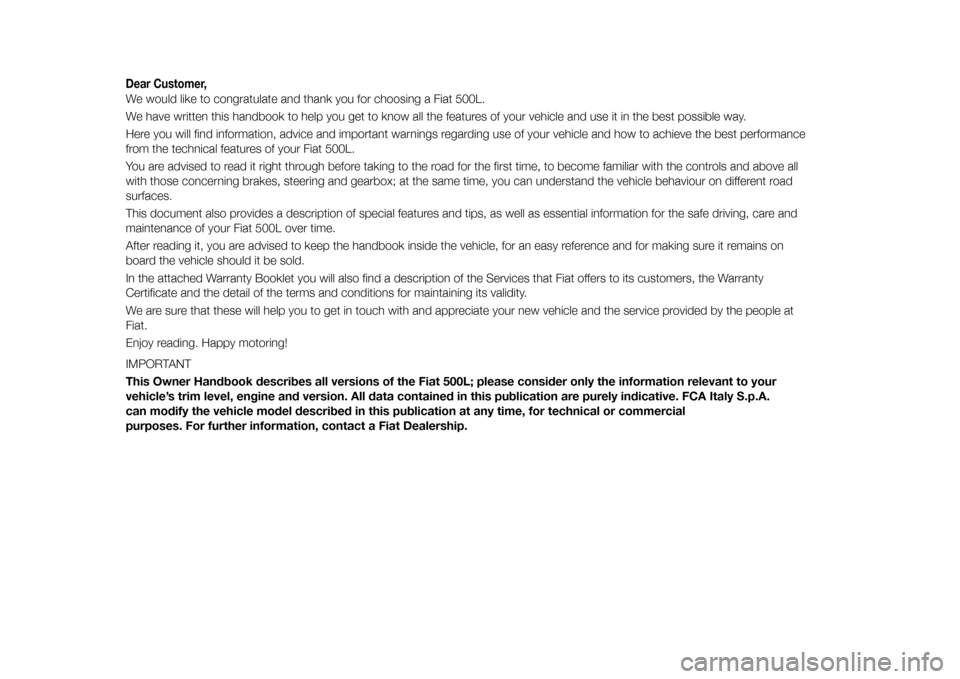
Dear Customer,We would like to congratulate and thank you for choosing a Fiat 500L.
We have written this handbook to help you get to know all the features of your vehicle and use it in the best possible way.
Here you will find information, advice and important warnings regarding use of your vehicle and how to achieve the best performance
from the technical features of your Fiat 500L.
You are advised to read it right through before taking to the road for the first time, to become familiar with the controls and above all
with those concerning brakes, steering and gearbox; at the same time, you can understand the vehicle behaviour on different road
surfaces.
This document also provides a description of special features and tips, as well as essential information for the safe driving, care and
maintenance of your Fiat 500L over time.
After reading it, you are advised to keep the handbook inside the vehicle, for an easy reference and for making sure it remains on
board the vehicle should it be sold.
In the attached Warranty Booklet you will also find a description of the Services that Fiat offers to its customers, the Warranty
Certificate and the detail of the terms and conditions for maintaining its validity.
We are sure that these will help you to get in touch with and appreciate your new vehicle and the service provided by the people at
Fiat.
Enjoy reading. Happy motoring!
IMPORTANT
This Owner Handbook describes all versions of the Fiat 500L; please consider only the information relevant to your
vehicle’s trim level, engine and version. All data contained in this publication are purely indicative. FCA Italy S.p.A.
can modify the vehicle model described in this publication at any time, for technical or commercial
purposes. For further information, contact a Fiat Dealership.
9-1-2015 12:9 Pagina 1
Page 68 of 224
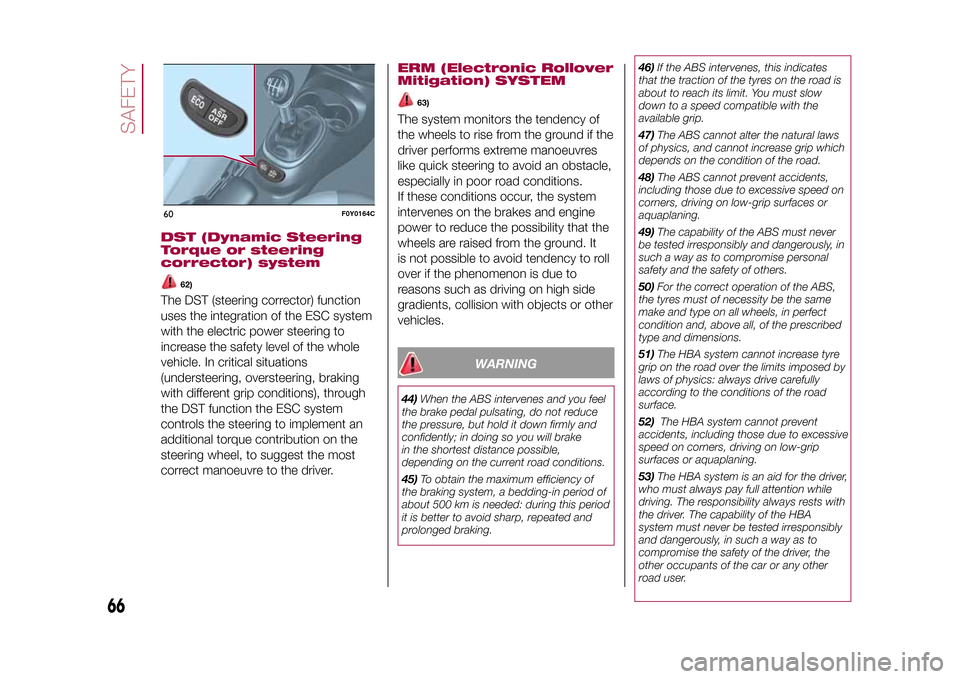
DST (Dynamic Steering
Torque or steering
corrector) system
62)
The DST (steering corrector) function
uses the integration of the ESC system
with the electric power steering to
increase the safety level of the whole
vehicle. In critical situations
(understeering, oversteering, braking
with different grip conditions), through
the DST function the ESC system
controls the steering to implement an
additional torque contribution on the
steering wheel, to suggest the most
correct manoeuvre to the driver.
ERM (Electronic Rollover
Mitigation) SYSTEM
63)
The system monitors the tendency of
the wheels to rise from the ground if the
driver performs extreme manoeuvres
like quick steering to avoid an obstacle,
especially in poor road conditions.
If these conditions occur, the system
intervenes on the brakes and engine
power to reduce the possibility that the
wheels are raised from the ground. It
is not possible to avoid tendency to roll
over if the phenomenon is due to
reasons such as driving on high side
gradients, collision with objects or other
vehicles.
WARNING
44)When the ABS intervenes and you feel
the brake pedal pulsating, do not reduce
the pressure, but hold it down firmly and
confidently; in doing so you will brake
in the shortest distance possible,
depending on the current road conditions.
45)To obtain the maximum efficiency of
the braking system, a bedding-in period of
about 500 km is needed: during this period
it is better to avoid sharp, repeated and
prolonged braking.46)If the ABS intervenes, this indicates
that the traction of the tyres on the road is
about to reach its limit. You must slow
down to a speed compatible with the
available grip.
47)The ABS cannot alter the natural laws
of physics, and cannot increase grip which
depends on the condition of the road.
48)The ABS cannot prevent accidents,
including those due to excessive speed on
corners, driving on low-grip surfaces or
aquaplaning.
49)The capability of the ABS must never
be tested irresponsibly and dangerously, in
such a way as to compromise personal
safety and the safety of others.
50)For the correct operation of the ABS,
the tyres must of necessity be the same
make and type on all wheels, in perfect
condition and, above all, of the prescribed
type and dimensions.
51)The HBA system cannot increase tyre
grip on the road over the limits imposed by
laws of physics: always drive carefully
according to the conditions of the road
surface.
52)The HBA system cannot prevent
accidents, including those due to excessive
speed on corners, driving on low-grip
surfaces or aquaplaning.
53)The HBA system is an aid for the driver,
who must always pay full attention while
driving. The responsibility always rests with
the driver. The capability of the HBA
system must never be tested irresponsibly
and dangerously, in such a way as to
compromise the safety of the driver, the
other occupants of the car or any other
road user.
60
F0Y0164C
66
SAFETY
9-1-2015 12:9 Pagina 66
Page 135 of 224
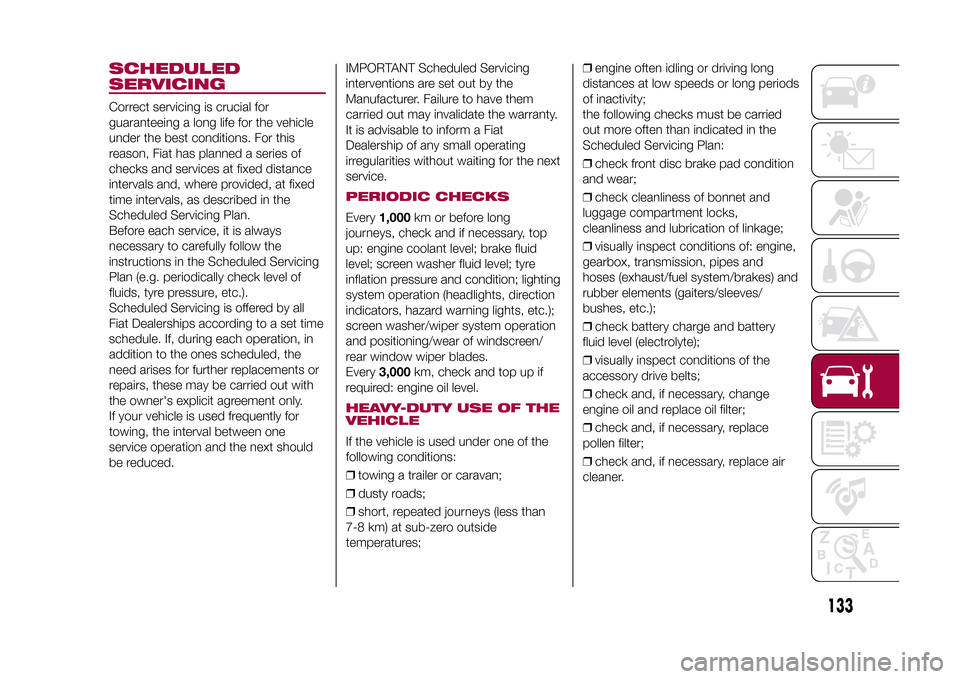
SCHEDULED
SERVICINGCorrect servicing is crucial for
guaranteeing a long life for the vehicle
under the best conditions. For this
reason, Fiat has planned a series of
checks and services at fixed distance
intervals and, where provided, at fixed
time intervals, as described in the
Scheduled Servicing Plan.
Before each service, it is always
necessary to carefully follow the
instructions in the Scheduled Servicing
Plan (e.g. periodically check level of
fluids, tyre pressure, etc.).
Scheduled Servicing is offered by all
Fiat Dealerships according to a set time
schedule. If, during each operation, in
addition to the ones scheduled, the
need arises for further replacements or
repairs, these may be carried out with
the owner's explicit agreement only.
If your vehicle is used frequently for
towing, the interval between one
service operation and the next should
be reduced.IMPORTANT Scheduled Servicing
interventions are set out by the
Manufacturer. Failure to have them
carried out may invalidate the warranty.
It is advisable to inform a Fiat
Dealership of any small operating
irregularities without waiting for the next
service.
PERIODIC CHECKSEvery1,000km or before long
journeys, check and if necessary, top
up: engine coolant level; brake fluid
level; screen washer fluid level; tyre
inflation pressure and condition; lighting
system operation (headlights, direction
indicators, hazard warning lights, etc.);
screen washer/wiper system operation
and positioning/wear of windscreen/
rear window wiper blades.
Every3,000km, check and top up if
required: engine oil level.HEAVY-DUTY USE OF THE
VEHICLEIf the vehicle is used under one of the
following conditions:
❒towing a trailer or caravan;
❒dusty roads;
❒short, repeated journeys (less than
7-8 km) at sub-zero outside
temperatures;❒engine often idling or driving long
distances at low speeds or long periods
of inactivity;
the following checks must be carried
out more often than indicated in the
Scheduled Servicing Plan:
❒check front disc brake pad condition
and wear;
❒check cleanliness of bonnet and
luggage compartment locks,
cleanliness and lubrication of linkage;
❒visually inspect conditions of: engine,
gearbox, transmission, pipes and
hoses (exhaust/fuel system/brakes) and
rubber elements (gaiters/sleeves/
bushes, etc.);
❒check battery charge and battery
fluid level (electrolyte);
❒visually inspect conditions of the
accessory drive belts;
❒check and, if necessary, change
engine oil and replace oil filter;
❒check and, if necessary, replace
pollen filter;
❒check and, if necessary, replace air
cleaner.
133
9-1-2015 12:9 Pagina 133
Page 136 of 224
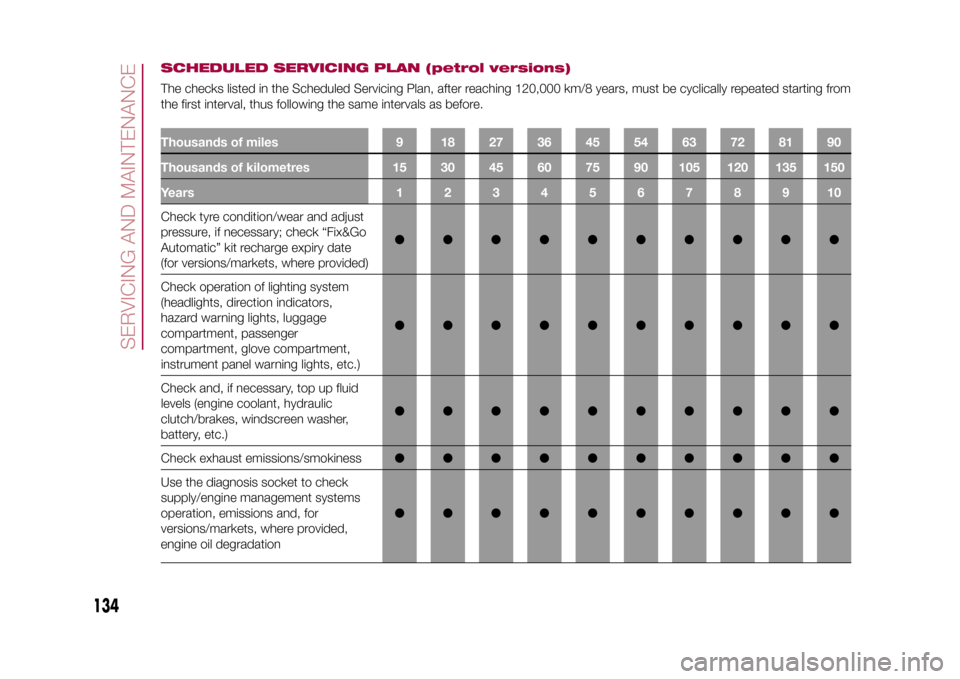
SCHEDULED SERVICING PLAN (petrol versions)The checks listed in the Scheduled Servicing Plan, after reaching 120,000 km/8 years, must be cyclically repeated starting from
the first interval, thus following the same intervals as before.Thousands of miles 9 18 27 36 45 54 63 72 81 90
Thousands of kilometres 15 30 45 60 75 90 105 120 135 150
Years12345678910Check tyre condition/wear and adjust
pressure, if necessary; check “Fix&Go
Automatic” kit recharge expiry date
(for versions/markets, where provided)●●●●●●●●●●
Check operation of lighting system
(headlights, direction indicators,
hazard warning lights, luggage
compartment, passenger
compartment, glove compartment,
instrument panel warning lights, etc.)●●●●●●●●●●
Check and, if necessary, top up fluid
levels (engine coolant, hydraulic
clutch/brakes, windscreen washer,
battery, etc.)●●●●●●●●●●
Check exhaust emissions/smokiness●●●●●●●●●●
Use the diagnosis socket to check
supply/engine management systems
operation, emissions and, for
versions/markets, where provided,
engine oil degradation●●●●●●●●●●
134
SERVICING AND MAINTENANCE
9-1-2015 12:9 Pagina 134
Page 137 of 224
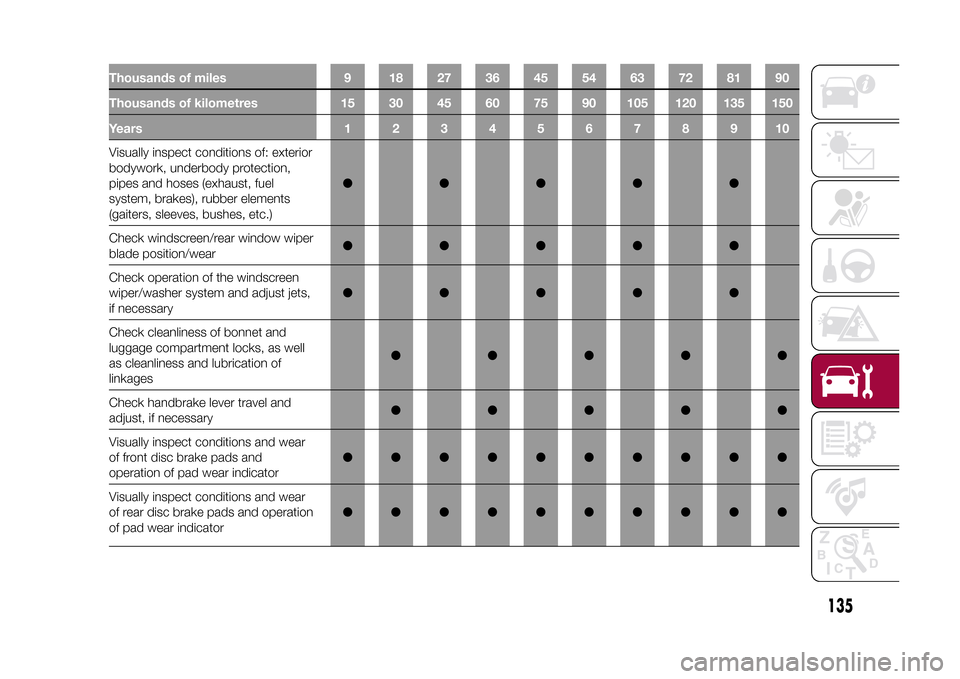
Thousands of miles 9 18 27 36 45 54 63 72 81 90
Thousands of kilometres 15 30 45 60 75 90 105 120 135 150
Years12345678910Visually inspect conditions of: exterior
bodywork, underbody protection,
pipes and hoses (exhaust, fuel
system, brakes), rubber elements
(gaiters, sleeves, bushes, etc.)●●●●●
Check windscreen/rear window wiper
blade position/wear●●●●●
Check operation of the windscreen
wiper/washer system and adjust jets,
if necessary●●●●●
Check cleanliness of bonnet and
luggage compartment locks, as well
as cleanliness and lubrication of
linkages●●●●●
Check handbrake lever travel and
adjust, if necessary●●●●●
Visually inspect conditions and wear
of front disc brake pads and
operation of pad wear indicator●●●●●●●●●●
Visually inspect conditions and wear
of rear disc brake pads and operation
of pad wear indicator●●●●●●●●●●
135
9-1-2015 12:9 Pagina 135
Page 142 of 224
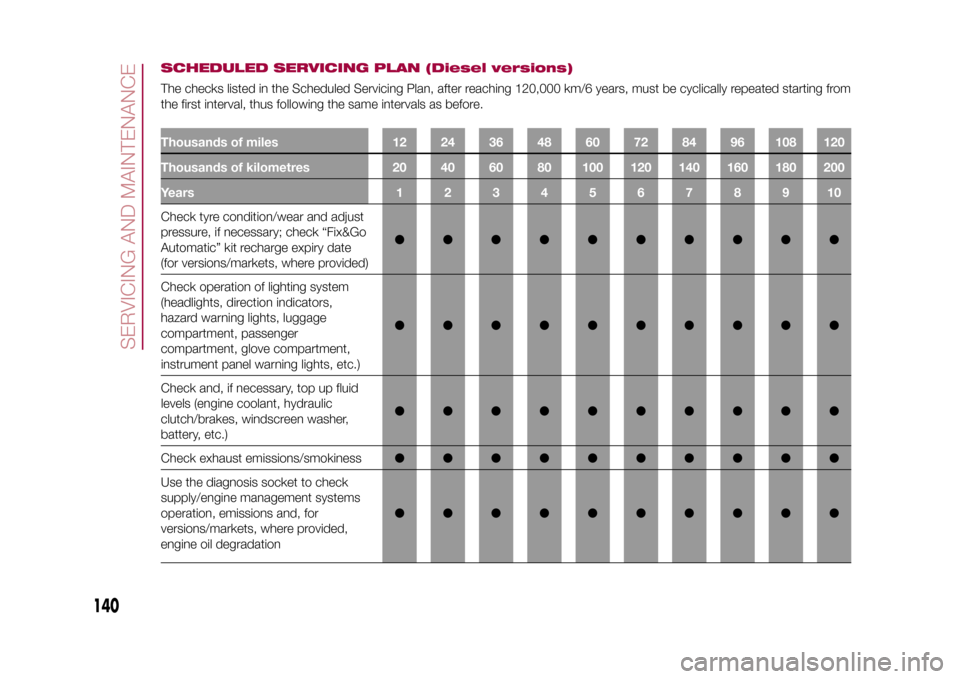
SCHEDULED SERVICING PLAN (Diesel versions)The checks listed in the Scheduled Servicing Plan, after reaching 120,000 km/6 years, must be cyclically repeated starting from
the first interval, thus following the same intervals as before.Thousands of miles 12 24 36 48 60 72 84 96 108 120
Thousands of kilometres 20 40 60 80 100 120 140 160 180 200
Years12345678910Check tyre condition/wear and adjust
pressure, if necessary; check “Fix&Go
Automatic” kit recharge expiry date
(for versions/markets, where provided)●●●●●●●●●●
Check operation of lighting system
(headlights, direction indicators,
hazard warning lights, luggage
compartment, passenger
compartment, glove compartment,
instrument panel warning lights, etc.)●●●●●●●●●●
Check and, if necessary, top up fluid
levels (engine coolant, hydraulic
clutch/brakes, windscreen washer,
battery, etc.)●●●●●●●●●●
Check exhaust emissions/smokiness●●●●●●●●●●
Use the diagnosis socket to check
supply/engine management systems
operation, emissions and, for
versions/markets, where provided,
engine oil degradation●●●●●●●●●●
140
SERVICING AND MAINTENANCE
9-1-2015 12:9 Pagina 140
Page 143 of 224
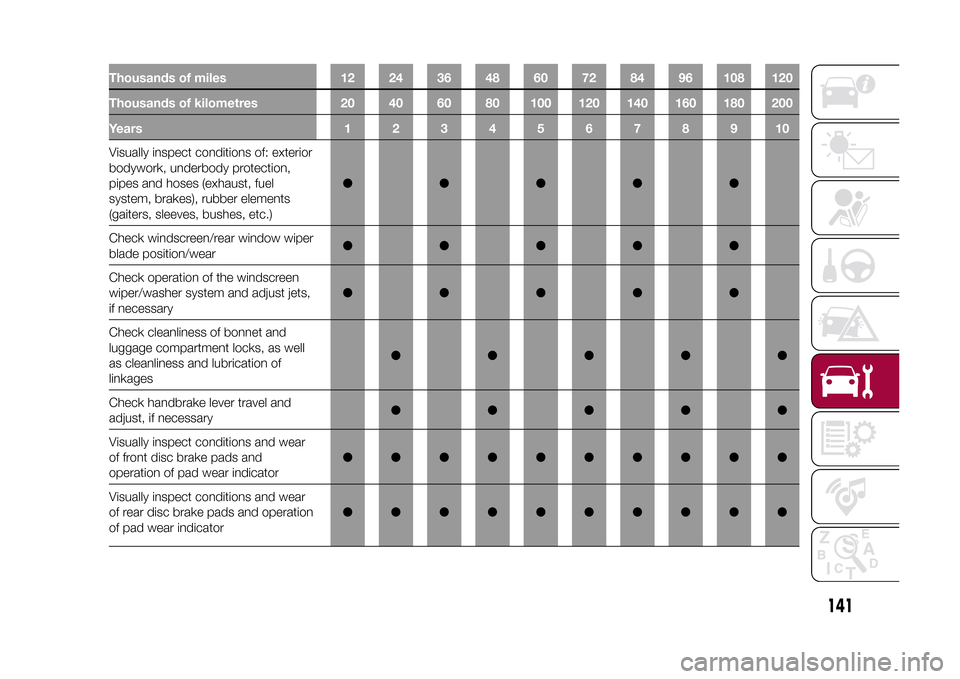
Thousands of miles 12 24 36 48 60 72 84 96 108 120
Thousands of kilometres 20 40 60 80 100 120 140 160 180 200
Years12345678910Visually inspect conditions of: exterior
bodywork, underbody protection,
pipes and hoses (exhaust, fuel
system, brakes), rubber elements
(gaiters, sleeves, bushes, etc.)●●●●●
Check windscreen/rear window wiper
blade position/wear●●●●●
Check operation of the windscreen
wiper/washer system and adjust jets,
if necessary●●●●●
Check cleanliness of bonnet and
luggage compartment locks, as well
as cleanliness and lubrication of
linkages●●●●●
Check handbrake lever travel and
adjust, if necessary●●●●●
Visually inspect conditions and wear
of front disc brake pads and
operation of pad wear indicator●●●●●●●●●●
Visually inspect conditions and wear
of rear disc brake pads and operation
of pad wear indicator●●●●●●●●●●
141
9-1-2015 12:9 Pagina 141
Page 186 of 224
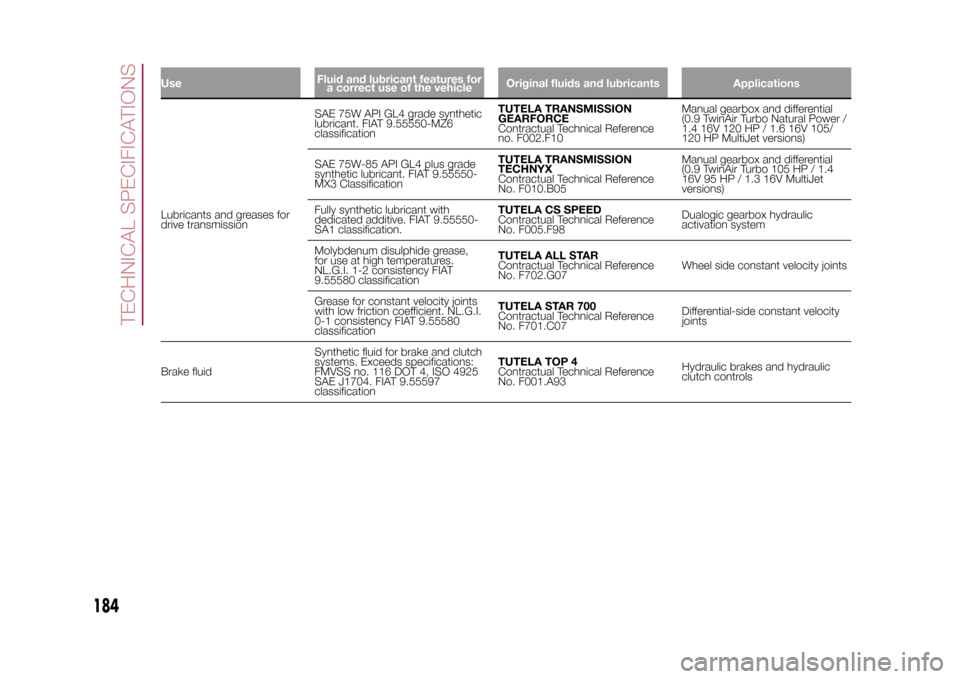
UseFluid and lubricant features for
a correct use of the vehicleOriginal fluids and lubricants ApplicationsLubricants and greases for
drive transmissionSAE 75W API GL4 grade synthetic
lubricant. FIAT 9.55550-MZ6
classificationTUTELA TRANSMISSION
GEARFORCE
Contractual Technical Reference
no. F002.F10Manual gearbox and differential
(0.9 TwinAir Turbo Natural Power /
1.4 16V 120 HP / 1.6 16V 105/
120 HP MultiJet versions)
SAE 75W-85 API GL4 plus grade
synthetic lubricant. FIAT 9.55550-
MX3 ClassificationTUTELA TRANSMISSION
TECHNYX
Contractual Technical Reference
No. F010.B05Manual gearbox and differential
(0.9 TwinAir Turbo 105 HP / 1.4
16V 95 HP / 1.3 16V MultiJet
versions)
Fully synthetic lubricant with
dedicated additive. FIAT 9.55550-
SA1 classification.TUTELA CS SPEED
Contractual Technical Reference
No. F005.F98Dualogic gearbox hydraulic
activation system
Molybdenum disulphide grease,
for use at high temperatures.
NL.G.I. 1-2 consistency FIAT
9.55580 classificationTUTELA ALL STAR
Contractual Technical Reference
No. F702.G07Wheel side constant velocity joints
Grease for constant velocity joints
with low friction coefficient. NL.G.I.
0-1 consistency FIAT 9.55580
classificationTUTELA STAR 700
Contractual Technical Reference
No. F701.C07Differential-side constant velocity
joints
Brake fluidSynthetic fluid for brake and clutch
systems. Exceeds specifications:
FMVSS no. 116 DOT 4, ISO 4925
SAE J1704. FIAT 9.55597
classificationTUTELA TOP 4
Contractual Technical Reference
No. F001.A93Hydraulic brakes and hydraulic
clutch controls
184
TECHNICAL SPECIFICATIONS
9-1-2015 12:9 Pagina 184
Page 213 of 224
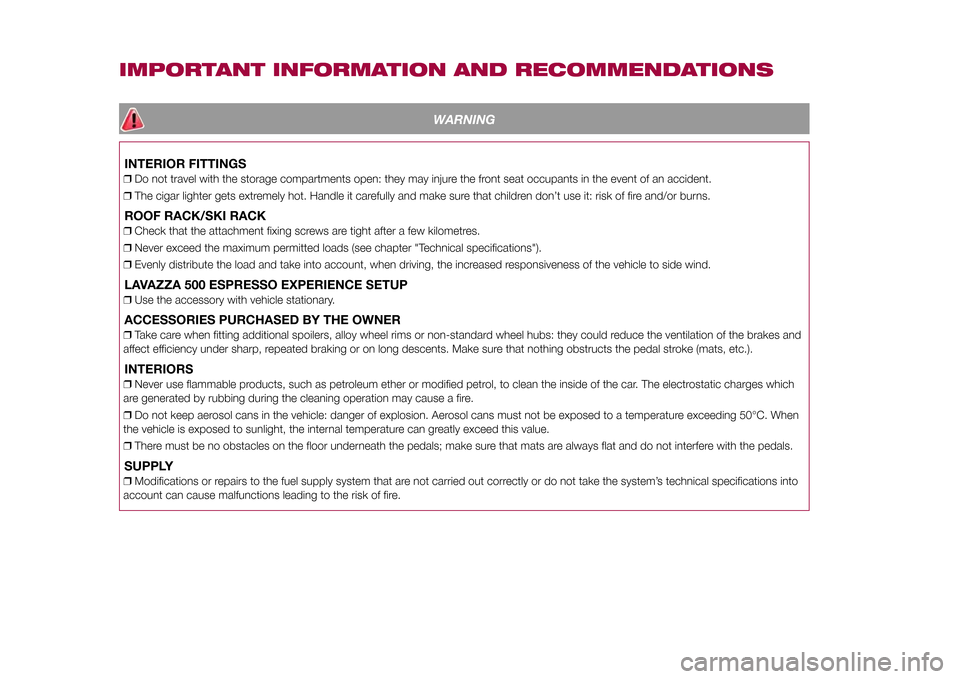
IMPORTANT INFORMATION AND RECOMMENDATIONS
WARNING
INTERIOR FITTINGS❒Do not travel with the storage compartments open: they may injure the front seat occupants in the event of an accident.
❒The cigar lighter gets extremely hot. Handle it carefully and make sure that children don’t use it: risk of fire and/or burns.ROOF RACK/SKI RACK❒Check that the attachment fixing screws are tight after a few kilometres.
❒Never exceed the maximum permitted loads (see chapter "Technical specifications").
❒Evenly distribute the load and take into account, when driving, the increased responsiveness of the vehicle to side wind.LAVAZZA 500 ESPRESSO EXPERIENCE SETUP❒Use the accessory with vehicle stationary.ACCESSORIES PURCHASED BY THE OWNER❒Take care when fitting additional spoilers, alloy wheel rims or non-standard wheel hubs: they could reduce the ventilation of the brakes and
affect efficiency under sharp, repeated braking or on long descents. Make sure that nothing obstructs the pedal stroke (mats, etc.).INTERIORS❒Never use flammable products, such as petroleum ether or modified petrol, to clean the inside of the car. The electrostatic charges which
are generated by rubbing during the cleaning operation may cause a fire.
❒Do not keep aerosol cans in the vehicle: danger of explosion. Aerosol cans must not be exposed to a temperature exceeding 50°C. When
the vehicle is exposed to sunlight, the internal temperature can greatly exceed this value.
❒There must be no obstacles on the floor underneath the pedals; make sure that mats are always flat and do not interfere with the pedals.SUPPLY❒Modifications or repairs to the fuel supply system that are not carried out correctly or do not take the system’s technical specifications into
account can cause malfunctions leading to the risk of fire.
9-1-2015 12:9 Pagina 206